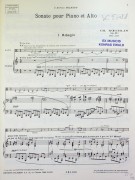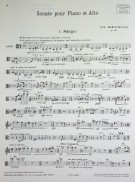
Charles Koechlin(1867–1950)
Sonata, op. 53, for Viola and Piano
Instrument List
Viola, Piano
Year (created)
1912/1915
Directory, No.
op. 53
Playing time approx.
27 Min.
Informationen
When Charles Koechlin (1867-1950) sketched a viola sonata in 1902, there was little he could draw upon. He had come to composing relatively late. Only after training to become an officer, suffering a serious illness (tuberculosis), and deciding to turn to music after all, did he begin his studies at the Paris Conservatory. Since 1890, he had mainly written songs in a somewhat lush style, related to Massenet and Fauré. His sketches for orchestral and chamber music works had produced few results that satisfied him. Only in 1911 did he feel ready to undertake a series of sonatas.
In the meantime, Koechlin had come into contact with Javanese gamelan music, was analyzing new works by his contemporaries Debussy and Ravel, and had immersed himself in the stories of Rudyard Kipling. With quiet persistence, he developed a highly personal and adventurous musical language, marked by wonder, curiosity, and a deep longing for untouched nature.
His Viola Sonata, Op. 53, represented a major step forward in the field of chamber music possibly even his best work from this period. Ten years after his initial sketches of an unfinished sonata, he returned to them and completed the piece in 1915. The four movements - Adagio (Très lent), Scherzo (Allegro molto animato et agitato), Andante (Presque adagio), and Finale (Allegro très modéré mais sourdement agité) - reflect Koechlin's ongoing development and refined craftsmanship. Incidentally, the finale is based on earlier sketches that had already found their way into his song Sur la grève (Op. 28, No. 1).
From 1912 onward, Koechlin worked continuously on several chamber music pieces at once: his First String Quartet (Op. 51), the Flute Sonata (Op. 52), the Viola Sonata, the Second String Quartet (Op. 57), and the Oboe Sonata (Op. 58). As he was nearing completion of the Viola Sonata, he wrote to his colleague and friend Darius Milhaud that the work was «dark and at the same time intimate». This sentiment resonated with the overall mood during the First World War, in which Koechlin and his wife served as medical volunteers for the Red Cross.
Charles Koechlin was, however, concerned that Milhaud whom he had dedicated the sonata to, and who, despite being trained as a violinist, gave the premiere on May 27, 1915 might feel burdened by the work's depth. Milhaud, on the contrary, thoroughly enjoyed the new «masterpiece», though Koechlin remained doubtful. The sweeping lines, complex rhythms, and dramatic contrasts might have been better suited to a different ensemble: perhaps a piano quintet, a cello sonata, or even an orchestral work. In 1926, he even considered orchestrating the sonata... fortunately, he never got around to it. Leo Samama
In the meantime, Koechlin had come into contact with Javanese gamelan music, was analyzing new works by his contemporaries Debussy and Ravel, and had immersed himself in the stories of Rudyard Kipling. With quiet persistence, he developed a highly personal and adventurous musical language, marked by wonder, curiosity, and a deep longing for untouched nature.
His Viola Sonata, Op. 53, represented a major step forward in the field of chamber music possibly even his best work from this period. Ten years after his initial sketches of an unfinished sonata, he returned to them and completed the piece in 1915. The four movements - Adagio (Très lent), Scherzo (Allegro molto animato et agitato), Andante (Presque adagio), and Finale (Allegro très modéré mais sourdement agité) - reflect Koechlin's ongoing development and refined craftsmanship. Incidentally, the finale is based on earlier sketches that had already found their way into his song Sur la grève (Op. 28, No. 1).
From 1912 onward, Koechlin worked continuously on several chamber music pieces at once: his First String Quartet (Op. 51), the Flute Sonata (Op. 52), the Viola Sonata, the Second String Quartet (Op. 57), and the Oboe Sonata (Op. 58). As he was nearing completion of the Viola Sonata, he wrote to his colleague and friend Darius Milhaud that the work was «dark and at the same time intimate». This sentiment resonated with the overall mood during the First World War, in which Koechlin and his wife served as medical volunteers for the Red Cross.
Charles Koechlin was, however, concerned that Milhaud whom he had dedicated the sonata to, and who, despite being trained as a violinist, gave the premiere on May 27, 1915 might feel burdened by the work's depth. Milhaud, on the contrary, thoroughly enjoyed the new «masterpiece», though Koechlin remained doubtful. The sweeping lines, complex rhythms, and dramatic contrasts might have been better suited to a different ensemble: perhaps a piano quintet, a cello sonata, or even an orchestral work. In 1926, he even considered orchestrating the sonata... fortunately, he never got around to it. Leo Samama
Genres
Sonata, Duet
Literature
• Ewald · Directory «Musik für Bratsche», CH, 2013
Publisher
• Senart, 1923
Media Center




